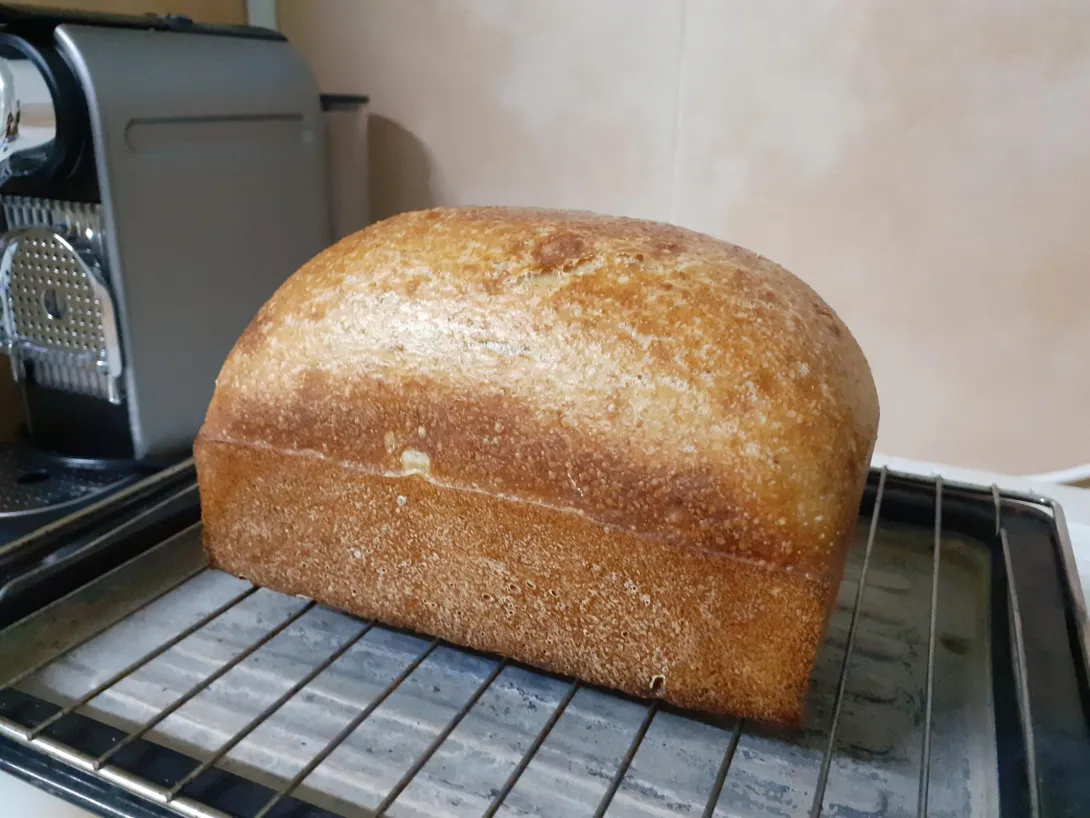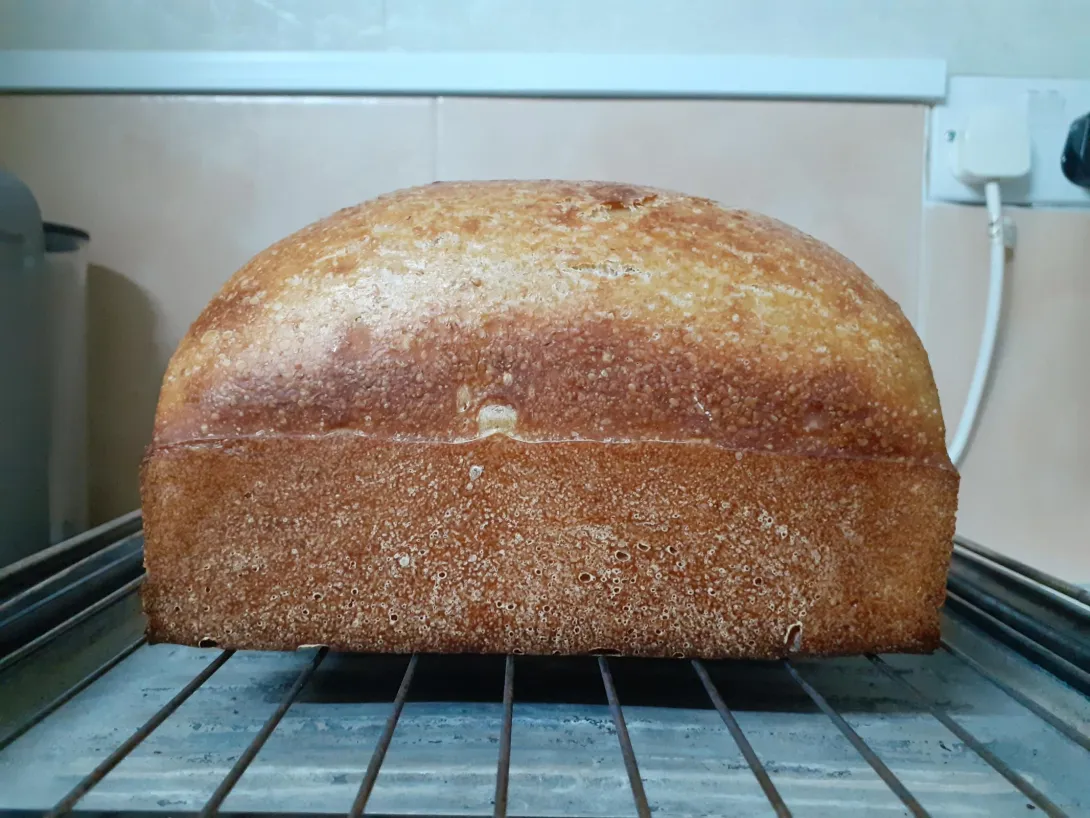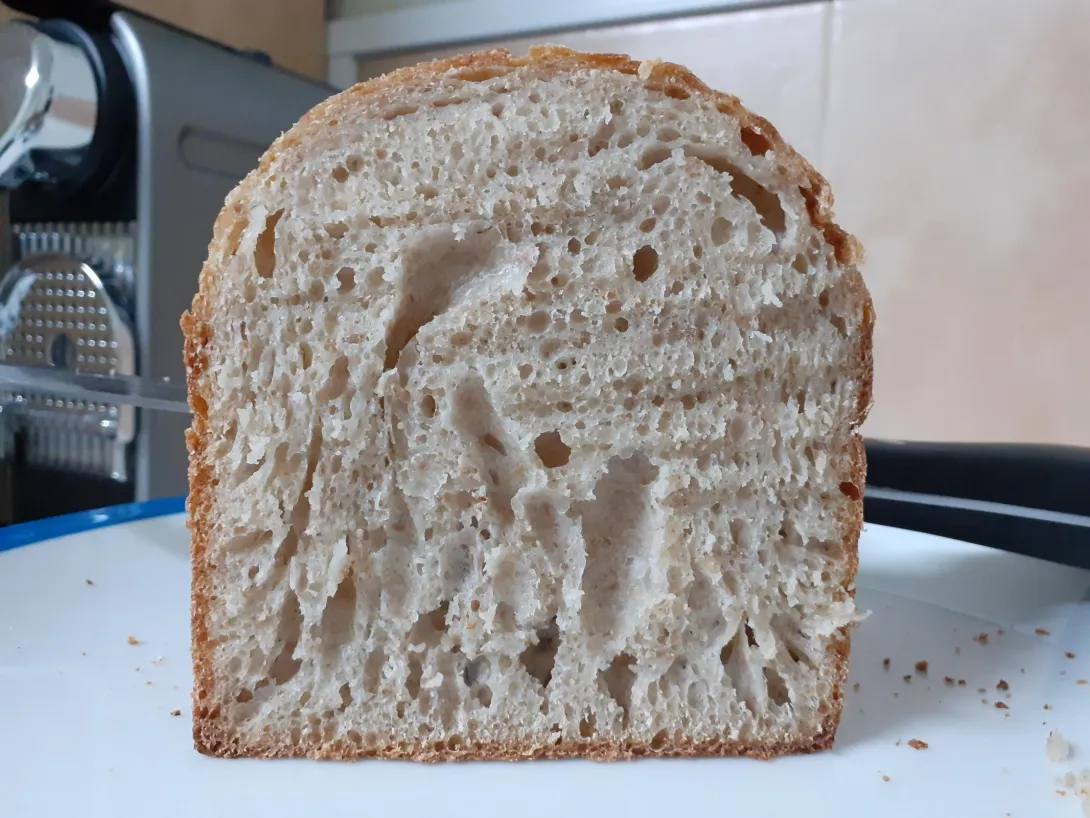
Well it's been a very long day. If good bread takes time then this is going to be one very tasty loaf. However I shall not count my chickens before I've seen the crumb and had a taste but so far so good.
Bought this beer with an idea to harvest the live yeasts and attempt to bake a loaf with it. While drinking the majority of it, making sure to save the dregs at the bottom of the bottle, I was reading up on this beer to see if anyone else had tried it. It is a popular tasty beer and some enthusiasts had tried to do this however with the idea to brew their own beer rather than bake with it. One comment struck me that I might have hit a brick wall when I read... because it's been matured for 100 days the yeasts are not very active. Challenge accepted!
Mixed a 90% hydrated pre-ferment using the beer and some bread flour. Over the course of 24 hours not a lot happened. Bubbles seemed to appear but then fizzle out. Every so often I stirred it. The mix had an appearance of a dough that's fermented by way of texture of the pre-ferment but no actual rise nor any apparent bubbles. At the end of 24 hours, which coincided with bedtime, there were more bubbles on top but still no rise. Added some more flour to thicken it up when immediately I picked up a new aroma of chocolate. The alcohol smell had disappeared half way through and it mellowed out a lot. This new nice aroma was interesting and because there was more bubbles in top I was hoping for a nice surprise come morning. Lo and behold the next morning it had clearly doubled... Onto the recipe.
- 400g bread flour
- 100g whole wheat flour
- 350g water
- 10g salt
- 105g pre-ferment
One hour fermentalyse then added the salt and proceeded onto the bulk ferment. My goodness it took it's time. The dough developed well but the chocolatey aroma had gone. The bubbles were very slow at first, then a few big ones started to appear which was encouraging but still no rise. Decided then it was going to be a game of patience. I will not move on from the bulk ferment till the the bulk ferment is done and the dough gets the nice aroma back. 10 hours later...
It was an odd dough. Now full of bubbles and smells good but only a very modest rise. Time to shape and hope for the best. Into the Pullman it went and while it shaped up well with a nice feel to the dough it probably rose by 50% when it seemed to lose its dome, flatten out and loads of bubbles appeared on the surface. It would not rise anymore so after 2.5 hours it was thrown in the oven hoping for the best.
...and much to my surprise the magic happened in the bake. Was expecting a modest rise and flat top and instead the oven spring was excellent and had domed top. The baking aroma was very good, the colour looks very inviting and from the feel of it the crust is thin with a nice crackling when gently squeezed. I'm still holding my breath expecting a false crumb so while I'm hopeful, the joke might be on me when it comes to slicing what looks like a nice loaf.
You can see the flat line where the dough stopped rising and the amount of oven spring. There's probably going to be a huge bakers cavern but let's wait and see...

I could have spent a few more days developing the beer starter and I'm sure it would have gained a lot of strength to become a fully matured but I was out of bread and locked into a deadline. I'm confident if I did this again with some more time spare the whole experience might be different. This was a fun experiment on a schedule.

As I thought... Needed some more strengthening before using. Bit of a false crumb but atleast there's no bakers cavern. Taste is excellent and overall a success. With a bit more time, just an extra day or two, this could have had perfect results. I'll return to this recipe with some more planning next time instead of a last minute experiment.
Looks really good Abe. Nice coloring in the crust. Hoping for a good crumb!
Crumb shot now included. Overall very happy with this bake and with a bit more TLC it could have turned out perfect. Taste is excellent and shall enjoy eating this loaf.
Excellent! Does any of the beer flavors come through, or is that lost in the bake?
Whether that's down to the beer itself lending flavour it's difficult to say. Actual amount of beer in the final loaf is minimal, about 40g ish. This had a very long ferment which would have brought out the natural flavours inherent in the flours. The crust has a lovely almost umami flavour.
Thanks Troy.
Beautiful loaf. Do you know why they have a picture of a loaf of bread on their page?
I'm assuming it's to do with the description of the flavours...
A fruit cake aroma... that sings of spices and raisins.
Interesting experiment Abe! Except for the obvious issue, the bread looks good, and I am sure next time you'll make it work beautifully.
I wonder if you can feed the yeast with a little sugar first, maybe it would wake them up quicker? Or add some diastatic malt? I expect either option should speed up the process, what do you think?
While it looks good it does have signs of a false crumb in the texture itself. I'm sure this would have gone better with time alone but also a good idea to try feeding it sugar. Next time!
Might also be worth trying a beer that hasn't been matured for so long so the yeasts are more active. This was an off the cuff experiment so next time I'll try locating another brand (even though this one is delicious but for sake of comparison) and see. I did however use the pre-ferment just as it had woken up and perhaps it wasn't far off from being much stronger.
Another splendid offering, Abe. Your recent posts have presented some excellent loaves. I do enjoy your refreshing detours down less-travelled country lanes in the land of bread!
So stoked it's nice to stray away from familiar territory and see what you can come up with. Keeps things interesting! Enjoyed the process a lot and it's certainly an avenue worth exploring some more perfecting my technique. The first one was never going to be perfect but I'm already forming ideas for the next loaf. The major factor being - more time to get a stronger ferment going before trying a recipe. I shall start half way through my current loaf next time instead of at the end.
Certainly an interesting experiment Abe, I’m sure you’ll find a more appropriate beer to make your levain with next time and have even better results.
Benny
There are many types of yeast used in brewing alcohol and after reading up on these live beers which are bottled conditioned it seems they often add a champagne yeast to finish off the process for its crisp flavour. Thought I'd try and see what these different yeasts bring to a baked loaf. This may very well be a good beer for the process I just think it needs more TLC. Kinda makes me want to try it again particularly to see if I can get a perfect loaf out of it. It is, after all, a very tasty beer. Perhaps next time use some of the beer for flavour too. As supposed to just the dregs to harvest the yeast.
Abe, this bake looks great and makes me want to try this beer. Hope I can find it in our area. I'll be following your progress. Re: your upcoming test, how can I tell the brewing time for a beer? I've never paid attention to that, and am guessing most labels don't make that info as obvious as the Fuller's.
I'm not too sure if this beer is available in your area but I'm sure you'll be able to find other bottle conditioned beers to give this method a try. Fuller makes a point of it being matured for 100 days which I would think other brands would also do as a selling point. If it doesn't specify then it probably hasn't been matured for so long. Should you try this method then use the dregs at the bottom, being careful to keep the bottle upright and pour slowly, which has all the good stuff you want to get the starter going. And give it all the time it needs. Once it begins to show promise then give it a few feeds to bring it up to strength.
Well done Abe.
I think you'll find residual yeast in just about all bottle conditioned beer and even ciders. It's just a question of how much and that's more to do with how it was fined (ie: was a clearing agent like irish moss or the like used aggressively to clear suspended particles before bottling). With bottle conditioning (as with your fullers) the bottling process will use some form of sugar - often dextrose - added to the beer just before being capped to give that last bit of residual yeast some food to create CO2 within the bottle within a week or two at room temp to get carbination. And the little bit of residual yeast left after conditioning, like a starter left in the back of your fridge without feeding for too long it'll be weak. Though it's nothing a few feedings can't fix.
The other question is will you get any beer flavour from your 'beer yeast' in the final loaf - likely not. But like most things in life it's the journey. And the process of feeding that starter will in the earliest stages release some interesting aromatic compounds. Feeding the starter with beer won't do much for it (or the beer!).
And using beer in place of some or all of the water (when you have the starter strong) will be interesting but maybe not meaningfully impact flavour. You'll likely see a darker crust but probably not much in the way of a big flavour difference. You could try using some very strong malty beers at that stage to try and push flavour forward. But avoid hoppy beers as that will likely add bitterness to the final bread and some off flavours from the heat on the hop oils - especially if it was dry hopped (additional hops added after the boil and during the fermentation stage).
All that said, your bread looks great! It's all good fun! Looking forward to watching this experiment progress.
PS. What size pan are you using? Looks like you're getting nice tall loaves.
PSS. You could always make your own beer while you're at it! :) https://www.beercraftr.com/1-gallon-beer-recipes/ Easy to do in apartments when only one gallon batches! Just say'n...
When opened this bottle began frothing like a volcano. How would I prevent this? I thought best to let it calm down before pouring but now I'm thinking perhaps I should carefully begin pouring it right away.
I like your comparison to it being like a starter that's been neglected for some time but 'nothing a few feedings can't fix". That's exactly what I was thinking. All my experiment lacked was a couple of extra feedings. Next time!
Will the different yeasts used to brew beers (I know there are many chosen for the outcome the brewer is looking for) lend different flavour profiles to the final loaf? Does the flavour of a bread come more from the yeast itself or more from the flour, the fermention time and how much sugar is eaten up or still available and the yeast is more for making gas bubbles? That's part of why I wished to see what the yeast brings to the loaf rather than the beer itself so only used a little of the beer instead of as flavouring too. If using beer as flavouring then it would be good to look up and learn which hope are used, I believe there are many kinds, and what their properties are.
I'm using a 2lb Pullman which is quite deep hence the tall loaves. Not sure on the dimensions but I can look it up.
I once made Meade which is very easy. Used a little yeast water to get the ferment going.
The fact you had a foam head of beer could be for several reasons: it was accidentally over bottle conditioned (too much sugars added right before bottling to create the carbonation - not likely as this is a commercial beer); it was intentionally over bottle conditioned because they like that way (try another to see if that's just how fullers like's them); kept in too warm a place and it reactivated some of residual yeast to eat the residual sugars in the beer (unlikely); was jostled around too much on the way home (maybe). Either way don't worry about keeping the beer carbonated as you'll lose that anyway through feedings, etc. And while you're at it be sure to enjoy your beers this way: https://www.youtube.com/watch?v=StMMa8uR2-0
Different beers and their yeast for different flavours: There are many different yeasts used to amplify different qualities in beers and the grains used to make them. But I suspect most of the yeast will end up dissipating aroma's early on in the starter feeding process. After all you are what you eat - and that applies to yeast as well here.. after several feedings the dominant flavours will come from flours and additions used. While you might notice subtle differences they may not be meaningful to warrant the trouble to find them. As mentioned above you could try boldly flavoured beers but then it's more about the flavour additions/characteristics of that beer that you can consider an "addition" rather than as a result of yeast expressing it's character.
Meade is easy to make. So too beer really. I've tried it a few times but it's just not something I enjoy drinking. I'm a hobby beekeeper so I have access to lots of honey. But I'd rather just enjoy the honey straight up, or on cheese or bread of course!
Bee well! :)
The question about bubbles wasn't about trying to keep them rather it was how to stop them from hurting out of the bottle when opening. There's a second or two when you think it's opened just like a normal bottle of beer and they come to the surface taking a while to stop. Perhaps I should pour some off straight away to allow more room for the bottle not to overflow. I've bought a other brand which I plan on starting tonight and get the first mix underway. It says on the bottle 'natural yeast' and not sure if it refers to wild yeast. If it's not wild yeast then what does natural yeast mean? Is there unnatural yeast in the beer fermenting world? Not sure what they're trying to say. Any clue?
I've never heard of beer being made with wild/spontaneous yeast. Yeast is from what I know always added after grains are steeped. Which yeast is recipe/beer-type specific. I think the use of 'natural' is just marketing to elicit a sense of wholesome authentic ingredients.
As to your beer gusher - seems odd and could be specific to the batch you have or some of the comments I made earlier. All that said as my Irish friends would say, be sure not to waste a drop!
And have decided on a different tactic. I'm going to make something akin to a beer starter first, using carob molasses and hot water, then once it's active I'll make a bread starter. While mixing it straight into some flour worked eventually I'm thinking a beer starter might bring them back to full animation quicker and then take to the flour more easily.
I've just opened this new bottle of beer and no volcanic explosions. People have talked about some beers being over carbonated just as you have. Be it the will of the beer maker or not.
Now I've gotta get drinking. Gosh, this is fun!
Also bottled conditioned of course however this one caught my eye for an interesting reason. Doesn't say if it's been bottled matured for a lengthy period either. We will see what this one brings.